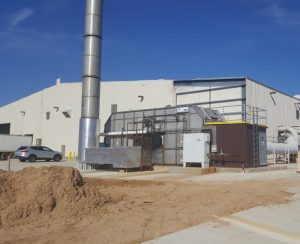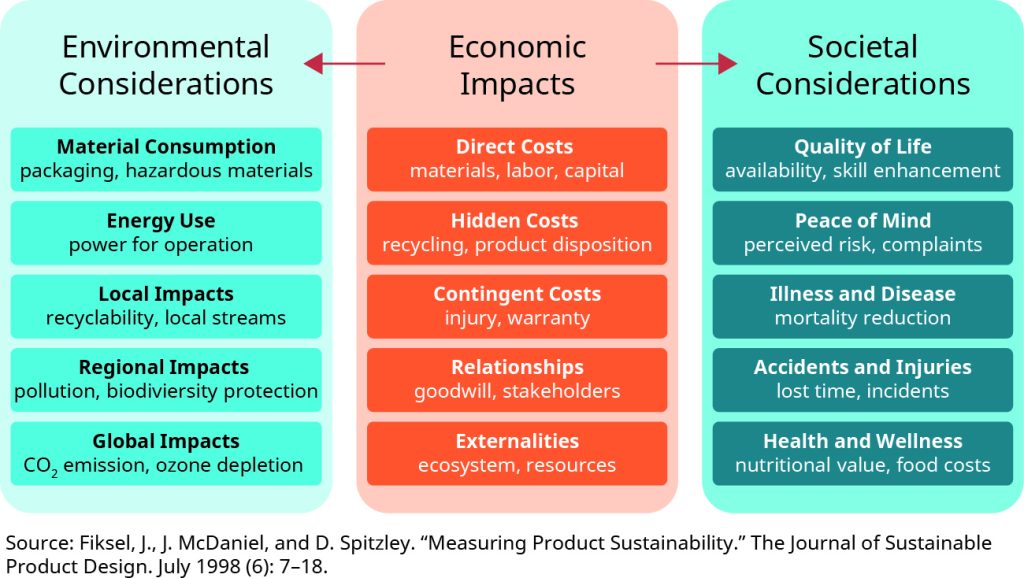6.1 Pollution and Sustainability
Joni Baumgarten
Section Goals:
- Conceptualize how pollution is a concept of our society.
- Define common pollutants.
- Understand cradle-to-grave analysis of impact.
Pollution as a Concept

As a person who lives in the built environment in the United States, it is easy to take for granted the concept of pollution and ideas of disposing of pollution on land or remediating land polluted with industrial chemicals. Pollution is the introduction of contaminants into the natural environment that cause adverse change. Pollution can take the form of any substance (solid, liquid, or gas) or energy (such as radioactivity, heat, sound, or light). Pollutants, the components of pollution, can be either foreign substances/energies or naturally occurring contaminants. Although environmental pollution can be caused by natural events, the word pollution generally implies that the contaminants have an anthropogenic source – that is, a source created by human activities.
To protect the environment from the adverse effects of pollution, many nations worldwide have enacted legislation to regulate various types of pollution as well as to mitigate the adverse effects of pollution.
Pollution control is a term used in environmental management. It means the control of emissions and effluents into air, water or soil (e.g., Figure 1 and Figure 2). Without pollution control, it has been the case that the waste products from overconsumption, heating, agriculture, mining, manufacturing, transportation and other human activities, degraded the environment. Ideally, pollution prevention and waste minimization are more desirable than pollution control.

The concept that natural lands and waters can act as filters, and that we can dispose of contaminants at levels that do not reach dangerous levels can be tied to specific scientific studies, such as the work of H. W. Streeter, a sanitary engineer, and Earle B. Phelps, a consultant for the U.S. Public Health Service. In 1925, working in the Ohio River, Streeter and Phelps developed an equation to measure the impact of contaminants based on how the contaminant reduced the total oxygen availability in the river. The Streeter–Phelps equation is used in the study of water pollution as a water quality modelling tool. Specifically, the model describes how dissolved oxygen decreases in a river or stream along a certain distance due to the oxygen demand of microbes degrading the biochemical. Based on this equation, acceptable limits of contamination can be calculated; below a threshold, the waters will act as a filter and the contaminants will not reduce the oxygen in the river to levels that would result in the death of most aquatic organisms (e.g., fish).
Types of Pollution
Various definitions of pollution exist, which may or may not recognize certain types such as noise pollution or greenhouse gases. The United States Environmental Protection Administration defines pollution as “Any substances in water, soil, or air that degrade the natural quality of the environment, offend the senses of sight, taste, or smell, or cause a health hazard. The usefulness of the natural resource is usually impaired by the presence of pollutants and contaminants.” In contrast, the United Nations considers pollution to be the “presence of substances and heat in environmental media (air, water, land) whose nature, location, or quantity produces undesirable environmental effects.”
The major forms of pollution are listed below along with the particular contaminants relevant to each of them:
- Air pollution is the release of chemicals and particulates into the atmosphere. Common gaseous pollutants include carbon monoxide, sulfur dioxide, chlorofluorocarbons (CFCs) and nitrogen oxides produced by industry and motor vehicles. Photochemical ozone and smog are created as nitrogen oxides and hydrocarbons react to sunlight. Particulate matter, or fine dust is characterized by their micrometer size PM10 to PM2.5. PM2.5 particulates are particularly dangerous due to their ability to penetrate deep into the lungs and enter the blood streams, causing health problems including cardiovascular disease, respiratory disease, and premature death.
- Electromagnetic pollution is the overabundance of electromagnetic radiation in their non-ionizing form, such as radio and television transmissions, Wi-fi etc. Although there is no demonstrable effect on humans there can be interference with radio-astronomy and effects on safety systems of aircraft and cars.
- Light pollution includes light trespass, over-illumination and astronomical interference (which causes the night sky to become lighter, blocking views of the stars, planets, etc.).
- Littering is the criminal throwing of inappropriate man-made objects, unremoved, onto public and private properties.
- Noise pollution encompasses roadway noise, aircraft noise, industrial noise as well as high-intensity sonar.
- Plastic pollution involves the accumulation of plastic products and microplastics in the environment that adversely affects wildlife, wildlife habitat, or humans.
- Soil contamination occurs when chemicals are released by spill or underground leakage. Among the most significant soil contaminants are hydrocarbons, heavy metals, herbicides, pesticides and chlorinated hydrocarbons.
- Radioactive contamination results from 20th century activities in atomic physics, such as nuclear power generation and nuclear weapons research, manufacture, and deployment.
- Thermal pollution is a temperature change in natural water bodies caused by human influence, such as use of water as coolant in a power plant.
- Visual pollution can refer to the presence of overhead power lines, motorway billboards, scarred landforms (as from strip mining), open storage of trash, municipal solid waste or space debris.
- Water pollution is caused by the discharge of water which enters a local waterway; it includes industrial wastewater from commercial and industrial waste (intentionally or through spills) into surface waters; discharges of untreated sewage and chemical contaminants, such as chlorine, from treated sewage; and releases of waste and contaminants into surface runoff flowing to surface waters (including urban runoff and agricultural runoff, which may contain chemical fertilizers and pesticides, as well as human feces from open defecation).
Triple Bottom Line and Life-Cycle Assessment
One way that Western Society has responded to the challenge of industrial pollution and the increased awareness of environmental damage and climate change is to analyze industry and development through a sustainability lens. This idea of sustainable development (as a modern term) is linked to the 1960s and 1970s, when people became more and more aware of environmental pollution.
Sustainability is a societal goal that relates to the ability of people to safely co-exist on Earth over a long time. Specific definitions of sustainability are difficult to agree on and have varied with literature, context, and time. However, sustainability is commonly described as having three dimensions (or pillars): environmental, economic, and social.
Sustainable development can be understood through the concept of a triple bottom line, which differs from traditional industry concern for just “the bottom line”, aka net income. The Triple Bottom Line, also known as TBL or 3BL, was first proposed in 1997 by John Elkington to expand the traditional financial reporting framework so as to capture a firm’s social and environmental performance. Elkington also used the phrase People, Planet, Profit to explain the three focuses of triple bottom line reporting.

Another innovation of this societal concern was life-cycle accounting. This reporting method took a “cradle to grave” approach to costing that put a price on the disposal of products at the end of their lives and then considered ways to minimize these costs by making adjustments in the design phase (Figure 3). This method also incorporated potential social, environmental, and economic costs (externalities in the language of economics) to attempt to identify all of the costs involved in production. For example, one early adopter of life-cycle accounting, Chrysler Corporation, looked the material costs, hidden manufacturing expenses, and liabilities associated with disposal of a newly-developed oil filter. They found that the option with the lowest direct costs had hidden disposal costs that meant it was not the cheapest overall mode of production.
Early study into the hows of sustainability reporting led researchers to suggest that some performance indicators could be quantified. Figure 4 shows the sustainable product indicators identified by Fiskel and colleagues (1998) with suggestions on how each element of economic output might also be measured from an environmental or societal stance.

Attributions
Pollution by Wikipedia is licensed CCA-SA 3.0. Accessed February 19, 2023. Modified by Joni Baumgarten.
Principles of Accounting: Volume 2 by OpenStax is licensed CC BY 4.0. Modified by Joni Baumgarten.
Streeter-Phelps Equation by Wikipedia is licensed CCA-SA 3.0. Accessed February 19, 2023. Modified by Joni Baumgarten.

